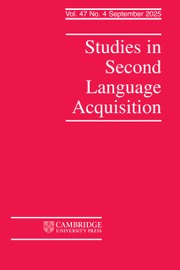Article contents
THE ACQUISITION OF PROGRESSIVE AND RESULTATIVE MEANINGS OF THE IMPERFECTIVE ASPECT MARKER BY L2 LEARNERS OF JAPANESE: Transfer, Universals, or Multiple Factors?
Published online by Cambridge University Press: 26 January 2007
Abstract
It has been observed that there is a strong association between the inherent (lexical) aspect of verbs and the acquisition of tense-aspect morphology (the aspect hypothesis; Andersen & Shirai, 1994). To investigate why such an association is observed, this study examined the influence of inherent aspect and learners' first language (L1) on the acquisition of Japanese imperfective aspect by using two tasks—an acceptability judgment test and an oral picture description task—with two groups of second language learners of Japanese: 26 native speakers (NSs) of English, which has the obligatory progressive, and 35 NSs of languages that have no obligatory progressive marking (German and Slavic languages). The results from the acceptability judgment test support the aspect hypothesis in that, regardless of L1, the imperfective marker -te i-ru was strongly associated with activity verbs for lower proficiency learners. However, the results from the oral task did not support the prediction, in that lower proficiency L1 nonprogressive learners did not show any such preference. The results suggest that L1 plays a role in the formation of the acquisition pattern predicted by the aspect hypothesis, but that given the complex interaction with task types and proficiency, L1 transfer cannot be the sole reason for the predicted association in the acquisition of Japanese -te i-(ru). It is argued that multiple factors are at work when learners create the form-meaning associations predicted by the aspect hypothesis.This article is based on research conducted as part of Sugaya's doctoral dissertation submitted to Ochanomizu University. We would like to thank Kevin Gregg, Yoshinori Sasaki, and the anonymous SSLA reviewers for their insightful comments on an earlier version of this article. We also thank Manabu Kurosawa for his invaluable advice on statistical analysis. We are grateful to Chie Morizuka, Hiromi Ozeki, Masuyo Sugiyama, Orie Takahashi, Yoko Mukoyama, Yukari Hashimoto, and the other participants of the seminar on SLA at Ochanomizu University for their helpful discussions of this study. We also thank the participants in the study for their cooperation and those who kindly helped us recruit them. This research is partially supported by a grant from the Japan Society for the Promotion of Science (Developmental Index for Japanese L1 and L2 Acquisition and Comparative Research on the Acquisition of English and Japanese, grant No. 13410034, PI-Kiyoshi Otomo, Tokyo Gakugei University). A preliminary analysis of the acceptability judgment test appeared in Nihongo Kyooiku (Journal of Japanese Language Teaching; Sugaya, 2004).
Information
- Type
- Research Article
- Information
- Copyright
- © 2007 Cambridge University Press
References
REFERENCES
- 28
- Cited by

